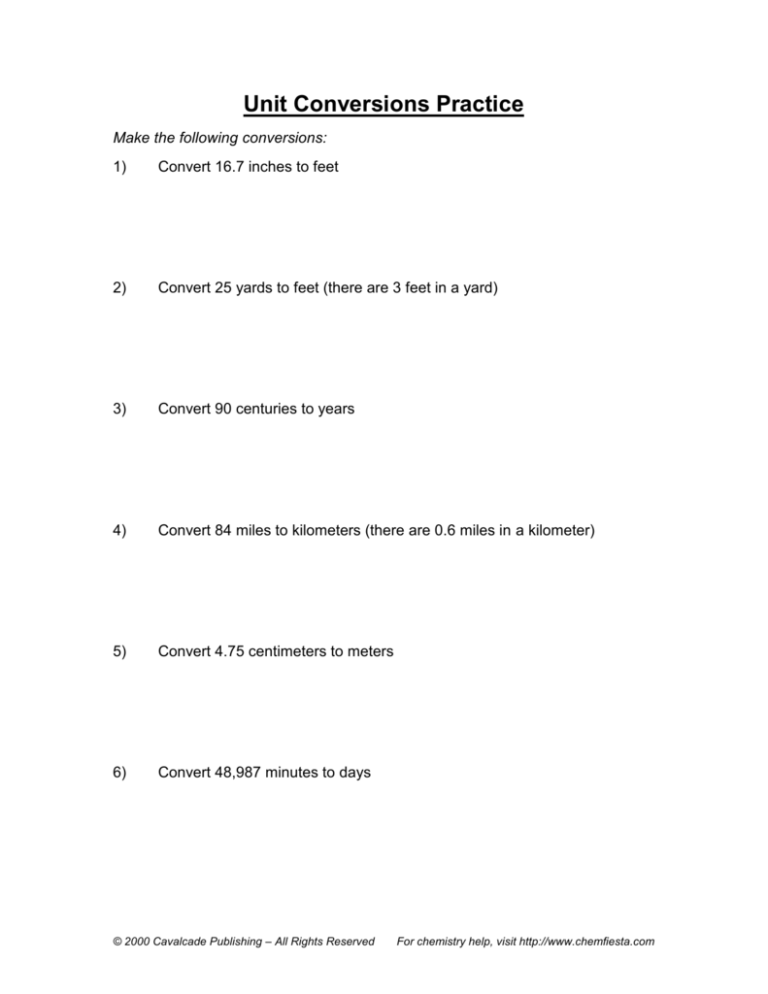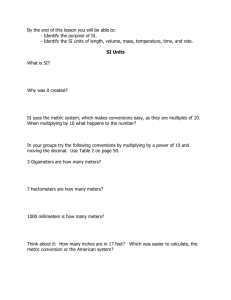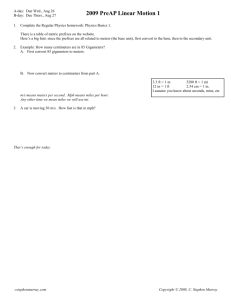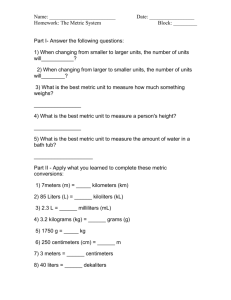
Unit Conversions Practice
Make the following conversions:
1)
Convert 16.7 inches to feet
2)
Convert 25 yards to feet (there are 3 feet in a yard)
3)
Convert 90 centuries to years
4)
Convert 84 miles to kilometers (there are 0.6 miles in a kilometer)
5)
Convert 4.75 centimeters to meters
6)
Convert 48,987 minutes to days
© 2000 Cavalcade Publishing – All Rights Reserved
For chemistry help, visit http://www.chemfiesta.com
7)
Convert 27 months to fortnights (there are 14 days in a fortnight and ~30
days in a month)
8)
Convert 0.09 miles to inches (there are 36 inches in a yard and 1760
yards in a mile)
9)
Convert 4.66 centimeters to miles (there are 0.6 miles in a kilometer)
10)
Convert 556 degrees Celsius to Kelvins
11)
Convert 25 Kelvins to degrees Celsius
© 2000 Cavalcade Publishing – All Rights Reserved
For chemistry help, visit http://www.chemfiesta.com
Unit Conversions Practice – Answer Key
1)
Convert 16.7 inches to feet
1.39 feet
2)
Convert 25 yards to feet (there are 3 feet in a yard)
8.3 yards
3)
Convert 90 centuries to years
9,000 years
4)
Convert 84 miles to kilometers (there are 0.6 miles in a kilometer)
140 km
5)
Convert 4.75 centimeters to meters
0.0475 meters
6)
Convert 48,987 minutes to days
34.019 days
7)
Convert 27 months to fortnights (there are 14 days in a fortnight and ~30
days in a month)
57.9 fortnights
8)
Convert 0.09 miles to inches (there are 36 inches in a yard and 1760
yards in a mile)
1.4 x 10-6 miles
9)
Convert 4.66 centimeters to miles (there are 0.6 miles in a kilometer)
2.8 x 10-5 miles
10)
Convert 556 degrees Celsius to Kelvins
829 K
11)
Convert 25 Kelvins to degrees Celsius
-2480 C
© 2000 Cavalcade Publishing – All Rights Reserved
For chemistry help, visit http://www.chemfiesta.com
MGCCC, Perk Learning Lab
Created by Tara L. Moore
Dimensional Analysis (Factor Label Method)
1.
1.2 kg
=
________dg
2.
2.00 x 10-5m =
________in
3.
25.4 mm
=
________cm
4.
1.2 miles
=
________km
5.
15.47 m3
=
________km3
6.
17.0 ft/s
=
________m/min
7.
342 miles/hr =
________km/s
8.
45.1 yards
=
________cm
9.
1.45 L
=
________gallons
10.
4.100 g
=
________mg
11.
1.2 kg/yard
=
________lbs/m
12.
2.00ft3/min
=
________L/hour
13.
145 ml
=
________cm3
14.
6.51 miles
=
________cm
ANSWERS
1.
2.
3.
4.
5.
6.
7.
8.
9.
10.
11.
12.
13.
14.
1.
2.
3.
4.
5.
6.
7.
8.
9.
10.
11.
12.
13.
14.
1.2 x 104 dg
7.87 x 10 –4 in
2.54 cm
1.9 km
1.547 x 10 –8 km3
311 m.min
0.153 km/s
4.12 x 103
0.383 gallon
4.100 x 103 mg
2.9 lbs/m
3.40 x 103 L/hr
145 cm3
1.05 x 106 cm
MGCCC, Perk Learning Lab
Metric to Metric Conversions
1.
14.4 m
= __________ cm
2.
564 cg
= __________ g
3.
58dg
= __________ mg
4.
800L
= __________ kL
5.
0.0687 km
= __________ mm
6.
51.0 hg
= __________ g
7.
210 cL
= __________ dL
8.
4.51 x 103 = __________ mL
9.
45700 cg
= __________ kg
10.
24.6 kL
= __________ L
11.
82.4 nm
= __________ m
ANSWERS
1.
2.
3.
4.
5.
6.
7.
8.
9.
10.
11.
1.
2.
3.
4.
5.
6.
7.
8.
9.
10.
11.
1440cm
5.64 g
5800 mg
0.800 kL
68700 mm
5100 g
21.0 dL
4.51 mL
0.457 kg
2.46 x 10 10 L
.0824 m
Conversions
Reg Chemistry
1. In the United Kingdom, British Rail runs two types of modern high speed passenger trains. The
Intercity-125 and the Intercity-225. The Intercity-125 has a top speed of 125 mi/hr, whereas the
newer Intercity-225 has a top speed of 225 km/hr. Which train is faster?
2. The radius of an atom is 1 x 10 -10 m. What is this radius in centimeters? In inches?
3. You are in Paris, and you want to buy some peaches for lunch. The sign in the fruit stand
indicates that peaches are 11.5 francs per kilograms. Given that there are approximately 5 francs to
the dollar, calculate what a pound of peaches will cost in dollars.
4. At the mall, you decide to try on a pair of Italian jeans. Naturally, the waist size of the jeans is
given in centimeters. What does a waist measurement of 52 cm correspond to in inches?
5. You pass a road sign saying “New York, 110 km”. If you drive at a constant speed of 65 mi/hr,
how long should it take you to reach New York?
6. For a pharmacist dispensing pills or capsules, it is often easier to weigh the medication to be
dispensed rather than to count the individual pills. If a single antibiotic capsule weighs 0.65 g, and a
pharmacist weighs out 15.6 grams of capsules, how many capsules have been dispensed?
7. Earth is approximately 1.5 x 108 km from the sun. How many minutes does it take light to travel
from the sun to Earth? The speed of light is 3.0 x 10 8 m/s?
8. What is the price of a piece of gold wire 445 centimeters long that sells for $12.25 per foot?
9. The recommended adult dose of dextromethorphan, a drug used to treat cold is 35 mg/kg of body
mass. Calculate the dose in milligrams for a 175 lb person.
10. A rectangular box is 4.00 in. wide, 12.00 in. long, and 16.0 in. deep. Calculate the volume in both
cubic centimeter and in liter.
11. A car travels 35 miles on one gallon of gasoline. How many kilometers on one liter will it go?
12. A common brand of cough syrup comes in a 4 fl oz bottle. The active ingredient in the cough
syrup is dextromethorphan. For an adult, the standard dose is 2 teaspoons, and a single dose
contains 20.0 mg of dextromethorphhan. Using the relationships, 1 fl oz = 29.6 mL and 1 teaspoon =
5.0 mL, determine how many grams of dextromethorphan are contained in the bottle
HELPFUL WEBSITES FOR CONVERSIONS:
http://www.learner.org/interactives/metric/symbols3.html
Metric to Metric Conversions
The essence of metric to metric conversions is recognizing the abbreviated base units.
Base Units: m (meter), L (liter), g (gram), s (seconds)
These are not all of the base units, but are the most common that you will encounter. Each base unit can
have any of the prefixes listed in the chart below. As with any other prefix, the prefix means the same thing
regardless of the abbreviated base unit it is attached to.
Giga (G)---------- it takes 109 (billion) base units = 1 G
Mega (M)--------- it takes 106 (million) base units = 1 M
----------------------------------------Kilo (K)----------- it takes 1000 base units = 1 K
Hecto (H)--------- it takes 100 base units = 1 H
Decka (Da)------- it takes 10 base units = 1 Da
Base Units: m, L, g, s
Deci (d)----------- it takes 1 base unit = 10 deci
Centi (c)---------- it takes 1 base unit = 100 centi
Milli (m)---------- it takes 1 base unit = 1000 milli
----------------------------------------Micro ()--------- it takes 1 base unit = 106 (million) micro
----------------------------------------Nano (n)---------- it takes 1 base unit = 109 (billion) nano
There are two ways to work metric to metric conversions. The first way is to do the math by using the
numerical conversion relationships listed in the chart above.
Ex: Convert 35 g to g.
? g = 35 g x 1 g
= 0.000035 g
1,000,000 g
The other way is to count the lines in the chart (every line except the one you start on), start from your
given information and counting each line until you get to what you want to convert.
***Move Up the chart: Move decimal to the LEFT
***Move DOWN the chart: Move decimal to the RIGHT (remember RIGHT DOWN to the nitty gritty)
Ex: Convert 35 g to g.
Begin at prefix (micro) and count UP to g (gram). You counted UP six places, therefore you move your
decimal to the LEFT six places. If your decimal is not shown, it is understood to be at the end of the
number.
35. g = 0.000035 g
Ex: Convert 0.26 ML to mL
Begin at prefix M (mega) and count DOWN to prefix m (milli). You counted DOWN nine places,
therefore, you move your decimal to the RIGHT nine places. So, you will add seven zeros.
0.26 ML = 260,000,000. mL
PRACTICE PROBLEMS (and solutions) ON BACK
PRACTICE PROBLEMS
1) 170.4 m =______________ cm
2) 564 Dag =______________ g
3) 58 dg =______________ mg
4) 600 L =______________ KL
5) 0.0923 Km =______________ mm
6) 49 Hg =______________ g
7) 210 cL =______________ dL
8) 4.51 x 103 L =______________ mL
9) 45700 cg =______________ Kg
10) 24.6 KL =______________ L
11) 82.4 nm =______________ m
ANSWERS
1)
2)
3)
4)
5)
6)
7)
8)
170400cm
5640 g
5800 mg
0.600 KL
92300 mm
4900 g
21.0 dL
4.51 mL; write out 4.51 x 103 L = 4510 L, the decimal is understood to be
after the zero. Now count UP from the prefix to the m (milli) prefix. You
counted three places, so move the decimal to the LEFT three places = 4.51 mL
9) 0.457 Kg
10) 2.46 x 1010 L or 24,600,000,000 L
11) 0.0824 m
Name _________________________
Lesson 1: Length
1. Which is longer? Circle your choice for each one.
1 mile or 1 kilometer
1 yard or 1 meter
2. Complete each statement.
1 mi = ________ km
1 yd = _________ m
1 inch or 1 centimeter
1 in = ________ cm
3. The basic unit of length in the metric system in the _________________ and is represented by a
lowercase ____.
4. The meter is defined as the _______________ traveled by _______________ in absolute vacuum in
1⁄299,792,458 of a second.
5. Complete each statement.
1 km = ___________ m
1 m = __________ cm
1 m = __________ mm
6. Which is larger? Circle your choice for each one.
A. 1 meter or 105 centimeters
C. 12 centimeters or 102 millimeters
B. 4 kilometers or 4400 meters
D. 1200 millimeters or 1 meter
7. How many millimeters are in 1 centimeter? __________
8. Use the ruler and line below to answer the questions.
What is the length of the line in centimeters? _______cm
What is the length of the line in millimeters? _______mm
What is the length of the line to the nearest centimeter? ________cm
HINT: Round to the nearest centimeter – no decimals.
T. Trimpe 2008 http://sciencespot.net/
Name_________________________
Metric Conversions
Fill in the boxes in the stair step diagram.
Try these conversions, using the ladder method.
1000 mg = _______ g
1 L = _______ mL
160 cm = _______ mm
14 km = _______ m
109 g = _______ kg
250 m = _______ km
Compare using <, >, or =.
56 cm
6m
7g
T. Trimpe 2000 http://sciencespot.net/
698 mg
Name_________________________
Metric Conversions
Write the correct abbreviation for each metric unit.
1) Kilogram _____
4) Milliliter _____
7) Kilometer _____
2) Meter _____
5) Millimeter _____
8) Centimeter _____
3) Gram _____
6) Liter _____
9) Milligram _____
Try these conversions, using the ladder method.
10) 2000 mg = _______ g
15) 5 L = _______ mL
20) 16 cm = _______ mm
11) 104 km = _______ m
16) 198 g = _______ kg
21) 2500 m = _______ km
12) 480 cm = _____ m
17) 75 mL = _____ L
22) 65 g = _____ mg
13) 5.6 kg = _____ g
18) 50 cm = _____ m
23) 6.3 cm = _____ mm
14) 8 mm = _____ cm
19) 5.6 m = _____ cm
24) 120 mg = _____ g
27) 5 g
29) 1,500 mL
Compare using <, >, or =.
25) 63 cm
26) 536 cm
6m
53.6 dm
28) 43 mg
508 mg
5g
T. Trimpe 2000 http://sciencespot.net/
30) 3.6 m
1.5 L
36 cm
Metric Mania Answer Keys
Conversion Practice
NOTE: See PowerPoint Presentation for the stair step boxes.
1000 mg = 1 g
160 cm = 1600 mm
109 g = 0.109 kg
1 l = 1000 ml
14 km = 14000 m
250 m = .250 km
56 cm < 6 m
7 g > 698 mg
Conversion Challenge
1. kg
2. m
3. g
4. ml
5. mm
6. l
7. km
8. cm
9. mg
10. 2 g
11. 104000 m
12. 4.8 m
13. 5600 g
14. .8 cm
15. 5000 ml
16. 0.198 kg
17. 0.075 l
18. 0.5 m
19. 560 cm
20. 160 mm
21. 2.5 km
22. 65000 mg
23. 63 mm
24. 0.12 g
25. <
26. >
27. =
28. =
29. <
30. >
T. Trimpe 2000 http://sciencespot.net/
Name_______________________________________Date____________Per_______
Writing Meters, Liters, and Grams
When Moving from one unit to a larger unit
No. of units
moved
Unit multiplied by
1
2
3
4
5
6
0.1
0.01
0.001
0.0001
0.00001
0.000001
When Moving from one unit to a smaller unit
No. of units
moved
1
2
3
4
5
6
1mm = .1cm
1 mm = .01 dm
1mm = .001 m
1mm = .0001dkm
1mm = .00001 hm
1mm = .000001 km
Unit multiplied by
10
100
1000
10000
10000
100000
.1 cm = 1mm
.01 dm = 1 mm
.001m = 1mm
.0001dkm = 1mm
.00001 hm = 1mm
.000001 km = 1mm
Give the missing decimals
1) 3 mm = _______cm
5) 6 cl = ________l
9) 25 cg =________g
2) 5cm = _______dm
6) 7 dl = ________dkl
10) 15g=________kg
3) 6dm= _______m
7) 9l= ________hl
11)32dg=________kg
4) 8m = ________dkm
8) 4ml= ________l
12) 98cg =________g
13) .3cm = _______mm
17) .06l = ________cl
21) .27g=________mg
14) .6m = _______dm
18) .08dkl = ________dl 22).15g=________mg
15) .4hm= _______dkm
19) .09hl= ________l
16) .9km = ________hm
20) .002l= ________ml 24).22hg=________g
Give the missing number
Christina Bryant 2009
23).052 dkg=_______cg
Write as decimals.
25) 37 mm=________cm
29) 276ml=________l
33) 378 g=______kg
26) 107cm=________m
30) 8,278ml=________l
34) 56g=_______kg
27) 1,529m=________km
31) 27ml=________l
35)9,762g=______kg
28) 26cm=________m
32) 4,010ml=_____l 3 36)8,920g=________kg
Christina Bryant 2009
CHEMISTRY
CONVERSIONS
1. A Tollycraft 61 Motor Yacht travels at 23.7 knots at full speed. A knot is the same as a nautical
mile per hour. A nautical mile is 1.852 kilometer. What is the full speed of the yacht in meters per
second?
2. A spaceship from another planet travels at a speed of 4.27 googs/mulm. There are 256 googs in a
meter and 8000 mulum in one hour. What is the spaceship speed in meters per second?
3. Arrange these items in order from shortest to longest: a 57 cm length of string, a 14 inch long
shoe, and a 1.1 m length of pipe.
4. What is the engine piston displacement in liters of an engine whose displacement is listed as 450
in3?
5. You pass a road sign saying “New York 112 km”. If you drive at a constant speed of 65 mi/hr, how
long should it take you to reach New York?
6. Suppose your dorm room is 11 ft wide by 12 ft long by 8.5 ft high and has an air conditioner that
exchanges air at a rate of 1200 L/min. How long would it take the air conditioner to exchange the air
in your room once?
7. How many liters of milk are in 835 gallons?
8. There are 2.60 x 1015 short tons of oxygen in the atmosphere (1 short ton = 2000 lb). How many
metric tons of oxygen are present (1 metric ton = 1000kg)?
9. A furniture factory needs 31.5 ft2 of fabric to upholster one chair. Its Dutch supplier sends the
fabric in bolts of exactly 200 m2. What is the maximum number of cahirs that can be upholstered by 3
bolts of fabric (1 m = 3.281 ft)?
10. A hot air balloon rises to a height of 1.2 km. The passenger reaches down 0.81 m below the
balloon basket holding a 1.3 m stick. At the end of the stick is a ball with a diameter of 32.1 cm and a
2.7 m string hanging from the ball is connected to a small lead weight. How high (in m) is the weight
above the ground?
11. An average man requires about 2.00 mg of riboflavin (vitamin B2) per day. How many pounds of
cheese would a man have to eat per day if this were his only source of riboflavin and if the cheese
contained 5.5µg (1 g contains 1,000,000 µg?
12. A graduated cylinder weighed 68.1 grams. To the cylinder was added 48.7 grams of water and
5.318 grams sodium chloride. What was the total mass of the cylinder and the solution? Express the
answer to the correct number of significant figures.
13. Use the following exact conversion factors to perform the stated calculations:
5.50 yards = 1 rod
40 rods
= 1 furlong
8 furlongs = 1 mile
a. The Kentucky Derby race is 1.25 miles. How long is the race in rods, furlongs, meters, and
kilometers?
b. A marathon race is 26 miles, 385 yards. What is this distance in rods, furlongs, meters, and
kilometers?
All students taking Chemistry or Acc. Chemistry will complete the attached worksheets and use the suggested websites
to review conversions problems and significant figures taught freshman year. The students will take a test on these two
topics on Friday, August 31, 2012. The Conversion assessment will be the first for the quarter and will be worth 100
point.
Any questions please email Mrs. Ortlieb at hortlieb@cdeducation.org or Mr. Nicolosi at rnicolos@ cdeducation.org after
th
August 15 , 2012.






